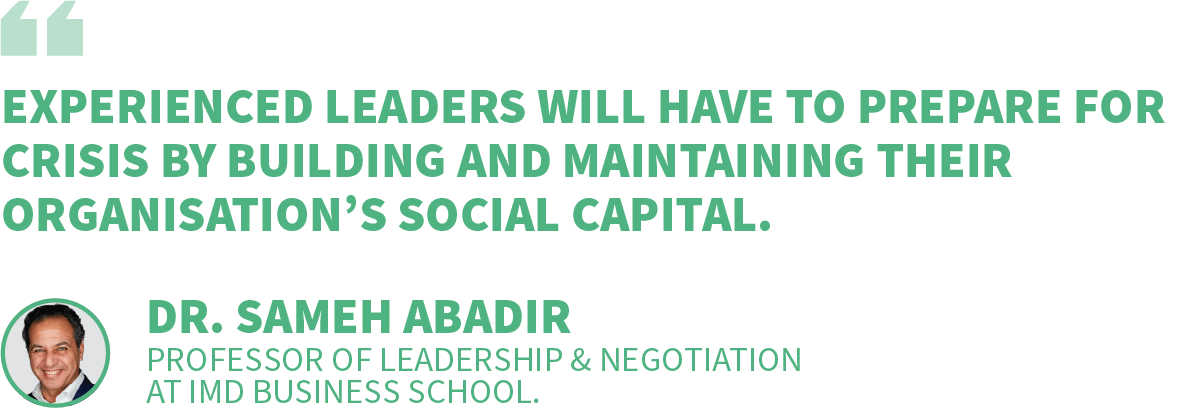23rd March 2021
It’s no secret that the nature of work has changed dramatically over the past year. Frequent disruptions to life’s usual routine has pushed businesses to adapt quickly to accommodate working from the office or at home, working with PPE or not - while keeping people safe.

An organisation's ability to survive these difficult times lies in its ability to be nimble and adaptive, with strong leadership at the helm. Leadership and safety are undeniably interdependent. An imbedded safety culture requires strong leadership that guides people and shows them how to behave.
Let’s face it, today’s leaders have greater challenges than ever before.
How can you develop stronger leadership skills?
It’s an interesting, multifaceted question, that doesn’t have a single, clear answer. Leadership itself, is a dichotomous topic in business. On the one it is a deeply individual process, with styles differing from person to person. On the other hand, the effects of good leadership are widespread and felt at a macro-level, potentially reaching thousands of people.
Clearly, it’s important to get it right.
You’re likely very familiar with the multitude of leadership content available. Countless theories, styles, and pieces of advice, all dedicated to upskilling leaders. However, with new perspectives on leadership coming out every week, it’s hard to find real, applicable advice that can create meaningful change.
We suggest a different approach, one that shifts the focus onto small, actionable changes that can be made every day. Breaking down improvements into incremental, achievable adjustments - as per the 1% Safer movement - is the secret to long-term success.
We’ve highlighted two relevant actions that act as the foundation for excellent leadership - and that can be realistically implemented on a day-to-day basis. These actions are key, especially in the rapidly changing global environment that 2021 brings.
Build Your Social Capital
The first step concerns who you work with and how you create supportive social structures within your organisations.
“Experienced leaders will have to prepare for crisis by building and maintaining their organisation's social capital.” notes Dr. Sameh Abadir, Professor of Leadership & Negotiation at IMD Business School, in his One Percent Safer book contribution. Social capital is the blanket term that describes how the various networks and strong relationships enable organisations to function effectively.
It’s true; President Abraham Lincoln was notorious for appointing his critics to the roles around him - people who weren’t afraid to disagree with him. Therein lies one of the first steps you can take to become 1% safer.
Ask yourself, who are you surrounded by? People who are confident and courageous enough to speak their mind? Or those who shy away from confrontation, and prefer to conform to the group consensus?

The right people in a group understand that respectful debate, critical thinking and frequent questioning is how the best decisions are made. It may feel uncomfortable or time-consuming, but those courageous enough to critique their leaders and managers will help reduce risk in the long run.
There is a term coined that describes when the group need for harmony results in irrational decision-making: groupthink. Groupthink happens when individuals feel that they can’t speak their mind for various reasons. As a result, the group makes a potentially bad decision. Within a leadership context, it’s essential to remain aware of groupthink and make sure that you foster an environment where this doesn’t occur, and people are comfortable to speak up.
Tragically, groupthink was one of the leading causes of the 1986 Challenger Disaster, where several engineers did not voice their opposition to the launch - which resulted in the shuttle’s catastrophic explosion. Had all people felt comfortable enough to speak their minds, the crisis might have been avoided.
Good leaders empower their employees to express criticism or feedback. This creates an environment where risks can be mitigated. Ultimately, building up your social capital will strengthen your organisation.
Do your employees feel empowered to speak up?

Show, Don’t Tell
Head of H&S for the AMG Petronas Formula One Team, Stuart Hughes, discusses how you need to create credibility as a leader to give meaning to your safety goals in his contribution to the 1% Safer book.
There’s no point repeating cheesy slogans about safety and instructing your workforce to follow multiple safety rules unless you’re actively enacting everything you say, as a leader.
People watch what their leaders do, taking cues from them to inform their own behaviour. We model authority figures, especially in a crisis. When risks are high, and the situation is changing everyday, we turn to leaders to guide us.
Leaders lose credibility by ignoring their own rules. Employees respect leaders less when they observe this behaviour - and safety rules lose valuable meaning when they’re not respected by those who enact them.
Why is leading by example so important? It comes down to one key factor: leading by example demonstrates integrity. Leaders cultivate cultures of trust when they follow through, doing and living as they say. Building trust with those they are leading, helps leaders to forge strong relationships and achieve the goals they’ve set for their organisation.

Therefore, this begs the question: Is safety a core value for you as a leader? Do you enact safe behaviours every day at work?
No matter which leadership position you hold in your organisation, safety should be at the core of your role as a leader. Leadership is after all, about people - developing strong relationships to help keep them safe and working at their best. Practicing what you preach creates the trust needed for an organisation to succeed in potentially uncertain times.
At the end of the day…
Effective leaders will strengthen their organisation. Putting people first ensures risk is minimised.
- Want to know more about creating incremental change in your organisations? Visit onepercentsafer.co.nz. ecoPortal health and safety software can help your business. Try a demo or get in touch with the team at ecoPortal.







